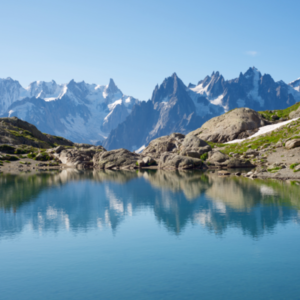Sinai In The Alps
 Suppose a Man was carried asleep out of a plain Country amongst the Alps and left there upon the Top of one of the highest Mountains, when he wak’d and look’d about him, he would think himself in an inchanted Country, or carried into another world; every Thing would appear to him so different to what he had ever seen or imagined before.
Suppose a Man was carried asleep out of a plain Country amongst the Alps and left there upon the Top of one of the highest Mountains, when he wak’d and look’d about him, he would think himself in an inchanted Country, or carried into another world; every Thing would appear to him so different to what he had ever seen or imagined before.
Thomas Burnet, 1684
Robert Macfarlane was hiking the Canadian Rockies:
“A big storm was on its way, according to the radio weather report I had listen to back at the road. Away to the east, I could see thunderheads congregating, and the valley was flooded with storm-light. It was a fixing light, which cast the scene – stilled it, held it. But it was also a light which made the most ordinary objects seem marvelous: the individual rocks around the shore, the slopes of snow lying between the firs, the pine-needles, like pairs of dividers, which had blown on to the lake ice.
But there was some thing even more strange about the waterfalls, and it took a few seconds before I realized what it was, and began to smile. All the waterfalls which were unfrozen were falling up the cliff face. It felt briefly as if I had been turned on my head, or the whole cliff face flipped upside-down. But no; it was the wind. The storm-wind which was blowing against the rock face was so strong that it was bullying the waterfalls back up the cliff. Where the water spilled over a lip of granite, it was plummeting upwards into the sky. These weren’t waterfalls, they were waterrises.”
Macfarlane, as always, takes us back in time to when explorers and thinkers were seeking to understand the world:
The most important member of the Zürich school was Conrad Gesner whose most famous act of rationalism took place on mount Pilatus, the peak which rises above Lucerne. The citizens of that city lived in fear of the malignant ghost of Pontius Pilate which was reputed to inhabit Lake Pilatus. Gesner and a friend climbed the mountain and cast stones down into the gray waters of the lake, in deliberate provocation of any supernatural entity which might have been lurking there. The waters didn’t erupt, the ghost of Pilate was not seen abroad, and no cataclysm immediately overtook Lucerne. Gesner’s symbolic exorcism of the citizens’ fears is now often taken to mark the beginning of the banishment of superstition from Western imagining of the mountains.
In 1541, Gesner wrote to his friend James Vogel on the subject of mountain-going:
“Men dull in mind find no cause for wonder anywhere; they idly sit at home instead of going to see what is on view in the great theatre of the world…
“Therefore I declare that man to be an enemy of nature who does not esteem high mountains worthy of a long study. Of a truth the highest parts of the lofty speaks seem to be above the laws that rule our World below, as if they belonged to another sphere. Up there the action of the all-powerful sun is not the same, nor is that of the air or winds.”
(“Mountains of the Mind” – A New Heaven and a New Earth, page 199-223)
******
I was dreaming of Sinai and couldn’t find my identity:
Was I Thomas Burnet, waking up on a mountain, “he would think himself in an inchanted Country, or carried into another world”?
Or
Was I Robert Macfarlane who found “fixing light,” and “waterrises”?
Would ‘On the third day, as morning dawned, there was thunder, and lightning, and a dense cloud upon the mountain, and a very loud blast of the horn; and all the people who were in the camp trembled (19:16 – sefaria.org),’ leave me trembling with Burnet or, “it took a few seconds before I realized what it was, and began to smile,” with Macfarlane?
“All the people saw the thunder and lightning, the blare of the horn and the mountain smoking; and when the people saw it, they fell back and stood at a distance (20:15),” would I fall back and tremble with Burnet, or “ It was a fixing light, which cast the scene – stilled it, held it. But it was also a light which made the most ordinary objects seem marvelous,” with Macfarlane?
I certainly would not slip into the superstitions of sixteenth-century Lucerne, but would I accept the scientific observations, “Of a truth the highest parts of the lofty peaks seem to be above the laws that rule our World below, as if they belonged to another sphere. Up there the action of the all-powerful sun is not the same, nor is that of the air or winds,” explaining the Sinai miracles as a Rationalist Gesner?
Who would twenty-first-century me be, “carried asleep out of a plain Country amongst the Alps and left there upon the Top of one of the highest Mountains, when he wak’d and look’d about him”?
******
I have been searching for Sinai and my place on it as described in “Sinai Dancing With Darwin,” “Sinai Off Cape Ann,” and, “How Small is Sinai.”
In fact, I have been searching all my life.
From the time my mother a”h would wake me up midnight Shavuot to watch for the sky to open so I could see Heaven I was convinced that Sinai was a very real place for me.
When my father zt”l would tell me bedtime Bible stories beginning with, “Picture the Scene,” I knew that I would find my place on Sinai. (Okay; I admit that I always imagined myself at Moshe’s side and not in the camp with everyone else. After all, where else would my father be, and I would be there holding his hand.)
It was difficult in Yeshiva listening to lectures about Sinai, and all of them, save one from Rav Avraham Turin z”l – Simchat Torah 1972 – failing to convey a sense the speaker had actually been there.
I still picture myself as a six-year-old at Sinai, completely safe holding my father’s hand, my mouth wide-open in wonder, thirstily drinking in every second of the experience,
- In an “Enchanted Country,”
- In “Another World,”
- Without superstition,
- Without rationalizations,
- Not as a scientist,
- Finding deep messages in “Light Fixing,” and,
- Secrets of existence in “Waterrises.”
- An invitation to learn to exist “In another sphere.”


